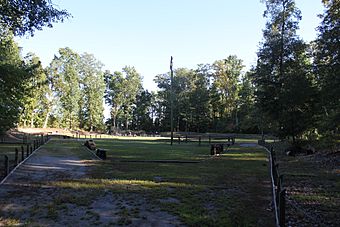Fort Huger facts for kids
|
Fort Huger
|
|
 |
|
| Location | Approx. 50 yds from jct. of Old Machlesfield Rd. and Macklesfield Ct., near Smithfield, Virginia |
|---|---|
| Area | 22 acres (8.9 ha) |
| Built | 1861 |
| NRHP reference No. | 08000320 |
Quick facts for kids Significant dates |
|
| Added to NRHP | April 16, 2008 |
Fort Huger is an old American Civil War fort located near Smithfield, Virginia in Isle of Wight County, Virginia. It sits on the south side of the James River, right across from another important spot called Fort Eustis. The fort was named after Major General Benjamin Huger, who was a Confederate general at the time it was built.
Fort Huger was a very important part of the Confederate Army's defenses along the James River from late 1861 to spring 1862. It helped protect the area during the war. Today, it's recognized as a historic archaeological site and was added to the National Register of Historic Places in 2008.
Contents
History of Fort Huger
Building the Fort
The location for Fort Huger was chosen in August 1861 by Colonel Andrew Talcott, a state engineer for Virginia. He picked a spot called Harden's Bluff. The idea was for Fort Huger to work with Fort Boykin (another fort on the south bank) and the Mulberry Point battery (on the north bank) to protect the James River.
Construction of the fort started right away. It was finished by March 1862. The fort was designed to hold 15 large cannons, and 13 of them were ready to fire. These cannons included big ones like 10-inch and 8-inch columbiads, and 9-inch Dahlgren shell guns. There were also six 32-pounder cannons that could fire hot-shot. Hot-shot were cannonballs heated up to a very high temperature to set enemy ships on fire!
The fort also had a special furnace to heat these cannonballs. The back of the fort was protected by an earthen wall that faced a swamp.
Challenges at the Fort
The soldiers stationed at Fort Huger were from the 5th Virginia Infantry Battalion. There were some early problems with who was in charge, but these were eventually sorted out.
People also noticed some issues with the fort's design. For example, there was no "clear zone" in the woods behind the fort. This meant attackers could sneak up without being seen easily. Also, some wooden buildings inside the fort could catch fire if they were hit by enemy shells. There were also no "bomb-proof shelters" where soldiers could hide during attacks.
Union Attack and Abandonment
On May 8, 1862, Fort Huger faced an attack from the Union Navy. A group of warships, including the USS Galena, USS Aroostook, and USS Port Royal, attacked the fort. They were part of a larger Union plan called the Peninsula campaign, which aimed to capture Richmond.
Another nearby fort, Fort Boykin, was quickly defeated and abandoned because its guns couldn't reach the Union ships. The Union ships then attacked Fort Huger. They eventually ran low on ammunition and had to pull back.
However, the Union ships returned on May 16, this time with powerful ironclad ships like the USS Monitor and USRC Naugatuck. After this new attack, the Confederate soldiers decided to disable their cannons and abandon Fort Huger. A Union report later showed that some of the earlier problems with the fort, like clearing the woods and building bomb shelters, had actually been fixed before it was abandoned.
Fort Huger Today
Today, Fort Huger is a public park! Isle of Wight County Parks and Recreation bought the site in 2005, and it opened to visitors in 2007.
Archaeologists are still working at the site, learning more about its history. If you visit, you can see five replica cannons that look just like the ones used during the Civil War. It's a great place to learn about history and imagine what it was like during the war.



